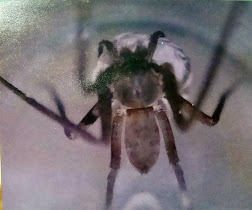Your Backyard as Laboratory and Workshop:
Entomology - the Science of InsectsDr Abe V Rotor
Former Professor in Entomology
UST Graduate School
The science of Insects is one of the least explored fields of biology because of their extreme diversity both genetic and environmental, their incredible persistence and wide adaptation. But to a keen observer, entomology can start on the backyard with unending source of specimen throughout the year. Take these examples.


Click Beetle, Family Elateridae, Order Coleoptera, also called snapping beetle. When the insect falls on it back, it snaps its neck to regain normal position. Snapping can be clearly heard so that it becomes a game of sort. Ask "How many loves have I or she?" And the click beetle either remains still or clicks, sometimes in succession.


Click Beetle, Family Elateridae, Order Coleoptera, also called snapping beetle. When the insect falls on it back, it snaps its neck to regain normal position. Snapping can be clearly heard so that it becomes a game of sort. Ask "How many loves have I or she?" And the click beetle either remains still or clicks, sometimes in succession.


June Beetle, Leucopholis irrorata Family Scarabidae, Order Coleoptera, also called May beetle when the rains arrive early and the beetle metamorphoses early. Its larva called grub ius destructive to plants by eating the roots. It lives almost a year underground, spends a week as pupa, then crawls out of the soil. The biological clock of ther June beetle - so with other organisms - leaves more puzzles than what science can explain.


Left, Tussock Moth caterpillars (higad) Order Lepidopera devour a leaf of castor bean seemingly unaffected by the toxin ricinin, (from which the plant derives its scientific name - Ricinus communis) - one of the most poisonous substances in nature. Right, a bunch of juvenile short horned grasshoppers (Oxya velox), Family Locustidae, Order Orthoptera.


Naiad or young of the dragonfly, Order Homoptera, (left) in its last instar about to metamorphose. It is aquatic in its naiad stage and feeds on mosquito wrigglers, other insects, daphnia, and the like, for many months, then metamorphoses into the winged cicada. It leaves its skin cast intact, often on the trunk of a nearby tree (right photo). Only the male cicada can produce music, which is actually a mating call. The female is born mute and is attracted by the singing of the male. A good singer may attract as many as five females, which is not the case with other organisms, including humans.


Wasp pollinator of fig (Ficus pseudopalma). Figs have inverted flowers, so that pollination and fertilization are done by a wasp (specific to the fig species). It the female wasp which enters the posterior opening (operculum) of the flower which looks like fruity, pollinates and fertilizers the flowers, at the same time lays eggs which will produced the next generation of pollinators.


Left, male rhinoceros beetle (Oryctes rhinoceros), Order Coleoptera. The male has elaborate and long horns like a miniature Triceratops, which are indeed menacing to its enemy though useless as tool of aggression. Rhino beetles are among the major pest of coconut, the larva or grub bores into the heart of the tree destroying the young leaves even before they are formed. Right, a stinkbug (Nezara viridula) Order Hemiptera, lay eggs in cluster. It earns its name from its characteristic bug odor that is obnoxious to its enemies such as birds and frogs - and to humans. The substance is caustic to the eye and skin.
Left, Cranefly, relative of the mosquito (Order Diptera) is also called as daddy-long-legs. It is constantly moving when it is supposed to be at rest. By swaying to and fro and side to side the insects is seen hazy to a would-be predator. In Ilocano we call the insect gingined (earthquake) because of its continuous quaking action. Right, a lone caterpillar prepares to attack a bud of Hibiscus (gummamela). It will metamorphose into a garden butterfly.
A relative of insects (Class Arachnida) this Wolsey Spider, a hairy large common house spider carries its egg sack to safety in preparation to hatching. Spiders are biological agents feeding on insect pest like mosquitoes, leafhoppers and weevils. The Wolsey spider got its name from Bishop Wolsey, right hand man of Henry VIII of England in the 14th century, who nearly died of fright on finding this spider in his bed. Wolsey died not because of the spider but because of ire of his cruel master. ~





No comments:
Post a Comment